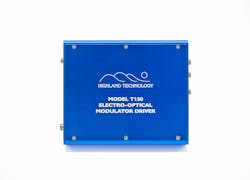Highland Technology introduces the T130, a USB/RS-232 enabled pulse generator
Highland Technology introduces the T130, a USB/RS-232 enabled pulse generator suitable for driving LiNbO3 Mach-Zehnder and similar electro-optical devices. Unlike typical telecom class EOM driver modules specified for balanced data operation, the T130 output can swing up to 7 volts relative to baseline and is capable of driving high Vpi EOMs at low duties down to single-shot.
A built-in edge-triggered width generator is adjustable for delay and width, spanning 250 picoseconds to 300 nanoseconds across three ranges. The T130 produces fast, low-jitter edge transitions, ideal for high-contrast optical gating and precision slicer EOM applications. Output voltage swing is adjustable from -0.5 volts to -7 volts into 50 Ohms. A 10:1 resistive pick-off enables monitoring the drive signal with a 50 Ohm oscilloscope.
The T130 includes a bias tee injection inductor for operation with single-port modulators. An integral adjustable -6 volts to +6 volts low-noise DC bias generator is included. A routing relay and dedicated SMA bias jack enable externally applied bias to be applied to the RF pulse. The BIAS SMA connector functions as a hi-z monitor of bias voltage when set to internal generator mode.
A Built In Self Test (BIST) routine monitors internal circuitry for nominal levels and features a fault detection LED.
The T130 is housed in a compact and rugged extruded aluminum enclosure, ideal for benchtop or OEM applications. An aluminum baseplate is included for surface mounting.
The T130 power requirement is +24 volts DC at 250mA, max. A locking barrel DC power connector provides secure retention and facilitates system integration.
In the absence of a computer, the T130 can operate under manual control mode using onboard trimpots and switches.
